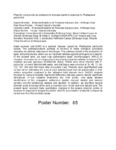Use este identificador para citar ou linkar para este item:
http://www.alice.cnptia.embrapa.br/alice/handle/doc/940515Registro completo de metadados
| Campo DC | Valor | Idioma |
|---|---|---|
| dc.contributor.author | MORALES, A. | pt_BR |
| dc.contributor.author | PEREIRA, A. A. | pt_BR |
| dc.contributor.author | CATELLI, L. | pt_BR |
| dc.contributor.author | BORÉM, A. | pt_BR |
| dc.contributor.author | MARCELINO-GUIMARÃES, F. C. | pt_BR |
| dc.contributor.author | OLIVEIRA, M. C. N. de | pt_BR |
| dc.contributor.author | MICHELLE A. GRAHAM | pt_BR |
| dc.contributor.author | HOFFMANN-CAMPO, C. B. | pt_BR |
| dc.contributor.author | ABDELNOOR, R. V. | pt_BR |
| dc.date.accessioned | 2012-11-26T11:11:11Z | pt_BR |
| dc.date.available | 2012-11-26T11:11:11Z | pt_BR |
| dc.date.created | 2012-11-26 | pt_BR |
| dc.date.issued | 2012 | pt_BR |
| dc.identifier.citation | In: MOLECULAR & CELLULAR BIOLOGY OF TE SOYBEAN, 14., Des Moines, 2012. [Proceedings...]. Des Moines: Iowa State University, 2012. | pt_BR |
| dc.identifier.uri | http://www.alice.cnptia.embrapa.br/alice/handle/doc/940515 | pt_BR |
| dc.description | Asian soybean rust (ASR) is a soybean disease caused by Phakopsora pachyrhizi Sydow. The phenylpropanoid pathway is involved in many biological processes including the defense response to the fungus. This pathway results in the production of lignin and phytoalexins, which are an important defense against pathogens and insects. In the present work, we used high performance liquid chromatography (HPLC) to measure the production of compounds in the phenylpropanoid pathway in leaves of the resistant soybean genotype (PI459025B, Rpp4). Plants were either infected with P. pachyrhizi or mock infected with water, and leaf tissue was collected at 24, 48, 72, 96, 120, 161, 308 and 504 hours after inoculation (hai). Phenolic peak quantification was carried out by estimating the area of each detected peak from all wavelengths or their relative proportion compared to the estimated total phenolic level. ANOVA analysis followed by Tukey?s Honestly Significant Difference test was used to identify significant differences (P<.05) between treatments and time points. This study allowed identification of the conjugated isoflavones daidzin, malonyl daidzin and malonyl genistin and the isoflavones dadzein and glycitein. In addition, we identified several phenolic acids including caffeic acid, p-coumaric acid, ferulic acid and salicylic acid. The present study revealed many quantitative changes in the soluble phenolic profile of soybean in response to fungus inoculation and the accumulation of specific compounds varied over the infection time course. | pt_BR |
| dc.language.iso | eng | eng |
| dc.rights | openAccess | eng |
| dc.title | Phenolic compounds accumulation in soybean plants in response to Phakopsora pachyrhizi. | pt_BR |
| dc.type | Resumo em anais e proceedings | pt_BR |
| dc.date.updated | 2018-04-16T11:11:11Z | pt_BR |
| dc.subject.thesagro | Soja | pt_BR |
| dc.subject.thesagro | Doença de planta | pt_BR |
| dc.subject.thesagro | Ferrugem | pt_BR |
| dc.subject.thesagro | Phakopsora Pachyrhizi | pt_BR |
| dc.subject.nalthesaurus | Soybeans | pt_BR |
| dc.subject.nalthesaurus | Plant diseases and disorders | pt_BR |
| dc.subject.nalthesaurus | Rust diseases | pt_BR |
| dc.format.extent2 | p. 136. | pt_BR |
| riaa.ainfo.id | 940515 | pt_BR |
| riaa.ainfo.lastupdate | 2018-04-16 -03:00:00 | pt_BR |
| dc.contributor.institution | AGUIDA MORALES | pt_BR |
| dc.contributor.institution | ALAN ALVES PEREIRA | pt_BR |
| dc.contributor.institution | LIZANDRA CATELLI | pt_BR |
| dc.contributor.institution | ALUÍZIO BORÉM | pt_BR |
| dc.contributor.institution | FRANCISMAR CORREA MARCELINO, CNPSO | pt_BR |
| dc.contributor.institution | MARIA CRISTINA NEVES DE OLIVEIRA, CNPSO | pt_BR |
| dc.contributor.institution | GRAHAM, M. A., USDA-ARS | pt_BR |
| dc.contributor.institution | CLARA BEATRIZ HOFFMANN CAMPO, CNPSO | pt_BR |
| dc.contributor.institution | RICARDO VILELA ABDELNOOR, CNPSO. | pt_BR |
| Aparece nas coleções: | Resumo em anais de congresso (CNPSO)  | |
Arquivos associados a este item:
| Arquivo | Descrição | Tamanho | Formato | |
|---|---|---|---|---|
| ID33816.pdf | 75,96 kB | Adobe PDF |  Visualizar/Abrir |









